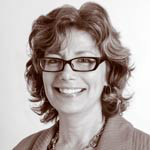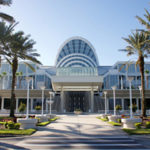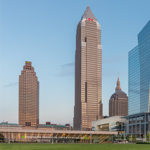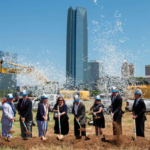That headline was spoken by Audrey Hepburn in the movie “Sabrina,” and the sentiment certainly holds true for international events today. That was confirmed for me when I attended the PCMA Global Professionals Conference – Europe in Paris on Aug. 30–Sept. 1, followed by a two-day tour of several hotels.

It was my first time in the City of Light, and as soon as I checked in to my host hotel, the Hyatt Regency Paris Etoile, I made a beeline to my bedroom window for my first glimpse of the Eiffel Tower. While I would see the airy steel landmark often throughout my stay — from a distance and up close — I felt a thrill each time, and was always reminded of its connection to our industry. The Eiffel Tower was built for the 1889 World’s Fair, an international exhibition. And although it was meant to be only a temporary installation — and at the time was considered an eyesore by most Parisians — it has become Paris’ most recognizable icon.
As I saw during our group’s breezy bus tour of the city before the conference got underway, and throughout my six-day visit, Parisians’ aversion to change in every other respect has been for the best. The past is gracefully preserved in architecturally awe-inspiring museums, bridges, parks, cathedrals, and buildings of every kind.
When it comes to the infrastructure that supports events, however, Paris is embracing the future. The program for the Global Professionals Conference — whose sponsors included Viparis (which manages the 10 main conference centers and event venues in the Paris-Ile-de-France region), the Paris Convention & Visitors Bureau, the Hyatt Regency Paris Etoile, Le Méridien Etoile, MCI, and Skyteam — provided a glimpse of beloved Paris sites as well as a look at new developments that demonstrate the city’s growing capacity to host world-class events.
BUILDING FOR THE FUTURE
The state-of-the-art Palais des Congrès de Paris, where the conference was held, offered one such example. The latest upgrade at the Palais — which includes a convention center, concert venue, and upscale shopping mall — is high-density Wi-Fi, delivering simultaneous connections to nearly 25,000 delegates at a significantly higher rate than standard networks.
Our two headquarters hotels — the 950-room Hyatt Regency Paris Etoile and the 1,025-room Le Méridien Etoile — both neighbor the Palais, and offer additional proof of continual upgrades to meet global delegates’ expectations. The Hyatt Regency, which has 25 meeting rooms and a 34th-floor bar with a killer view of the Eiffel Tower and city skyline, is in the midst of a complete renovation and redesign that will be completed by December 2017. Le Méridien Etoile, the largest business hotel in Paris, offers 25 meeting rooms — the most sizable of which can accommodate 1,200 people — and has just wrapped up an extensive two-year renovation of guest rooms and public areas.
The city’s biggest new development on the events front is the Paris Convention Centre, which is under construction at the Paris expo Porte de Versailles downtown. As part of the conference itinerary, we took a hard-hat tour of the center to get a taste of what international congresses can expect when the facility opens in January 2018. Viparis has invested $500 million in the ultramodern building, which will make the Porte de Versailles campus Europe’s largest exhibition facility. With nearly 474,000 square feet of exhibit space and 290,625 square feet of meeting rooms, the new center will be flooded with daylight and offer delegates a spectacular city view.

SESSIONS AND SITES
The education portion of the Global Professionals Conference – Europe, which brought together several dozen international meeting organizers and DMOs from more than 11 countries, kicked off with INSEAD professor and The Culture Map author Erin Meyer, who shared examples of how cultural norms play into business relationships around the world. (Read a recap of her session here.)
Other speakers included Catherine Lubochinsky, president of the European Money and Finance Forum, who lent an authoritative voice to the complicated subject of navigating European currency fluctuations; and Pierre-Henri Guignard, secretary general of the 2015 United Nations Climate Change Conference (COP21), which was held in Paris. Guignard presented a case study on managing risk for the two-week conference with 50,000 participants from 196 countries — including 157 heads of state — held less than three weeks after the Paris terror attacks. Obviously, COP21 required an abnormally high level of security, but as Guignard detailed safety plans for the event — from scheduling to catering to infrastructure — he underscored the reality that terrorism is an “element” in all conference preparation. “We need to be ready for it and we have to be resilient,” he said, “because the threat is coming from everywhere.”
Although Paris has experienced a 20-percent drop in hotel bookings since the attacks, we saw no evidence of that. The city was humming with tourists and business travelers, and throngs of visitors and locals were soaking up the end-of-summer warmth in outdoor cafés and parks along the bustling Avenue des Champs Elysées and the narrow streets of the Left Bank. The only hint of heightened security was a bag check at the entrance to the Hyatt.
During our tours and evening events, we experienced how Paris is one city made up of 20 different districts, or arrondissements — each feels like its own distinct village — that spiral out of the city’s center in numerical order. The vibe can change from one street to the next. For example, our first evening event was held at Le Pavillon Dauphine Saint Clair, a lovely Art Deco venue in a wooded garden in the 8th arrondissement that seemed miles away from the adjacent Champs Elysées.
After the second day of the conference, we floated along the River Seine aboard a Yachts de Paris vessel, where we tucked into tender beef enveloped in flaky pastry while drinking in views of monuments, museums, cathedrals, and parks on both banks. As dusk fell, the city sparkled and glowed.
Our closing dinner took place at the Hotel de Lauzun, a stunning mansion built in 1657, and hidden from view on Ile Saint-Louis, one of two natural islands on the Seine. Now owned by the city, the venue is only available for private groups. After a champagne welcome in the courtyard by Jean-Francois Martins, deputy mayor of Paris in charge of tourism and sports, and Nicholas Lefebvre, managing director of the Paris CVB, we headed upstairs and into the 17th century. There, richly carved, painted, mirrored, and gilded rooms painstakingly preserved from the time of Louis XIV overlook the Seine, a view we imagined has remained similarly unchanged over the past few centuries. We dined downstairs in the main hall, where the setting and sumptuous meal — veal filet mignon and creamy polenta with white truffles — not only concluded the program on a memorable note, but sealed the deal: Paris is always a good idea.
Beaucoup Hospitality
The Paris Convention & Visitors Bureau and Atout France extended my stay in Paris and arranged a two-day site visit of venues. That included my second host hotel, Le Méridien Etoile, where I experienced for myself how the property has been tastefully renovated, including its iconic Jazz Club and spacious lobby with plentiful, comfortable seating areas. The fresh redesign takes into account its roots as the flagship Le Méridien hotel launched by Air France in 1972, with such touches as Concorde-inspired lighting fixtures suspended above guest beds. The modern aesthetic is spare and sleek, from the moment you step into the lobby with its gold and red abstract-art installation, to its chic, paneled Ma Chère et Tendre steakhouse.
My next stop was the Hotel Peninsula, in the 16th arrondissement, a historic luxury hotel that first opened in 1908. Following an extensive rebuilding, the hotel reopened in 2014 as the 10th property in the Forbes Five-Star–rated Peninsula chain, with 200 luxury rooms, including 34 suites.
The Peninsula’s restaurant and terrace bar, l’Oiseau Blanc, has a French aviation theme that pays homage to the biplane of the same name, one of the first airplanes to attempt an Atlantic crossing. The Peninsula also offers a business center and five meeting rooms, among them the 1,850-square-foot Etoile Ballroom, and two of the smaller meeting rooms can be combined into a larger space.
After a quick look at the Peninsula’s state-of-the-art fitness center and turquoise indoor swimming pool, I thought I would have a hard time deciding between the two if I were a guest here to help cancel out my brioche-and-baguette carb spree. But after touring the luxurious 19,000-square-foot spa, I thought a massage and soak in the steam room might easily do the trick.
Next on my schedule was the Sofitel Arc de Triomphe, preceded by lunch at the property’s brand-new bistro Les Cocottes, where the seasonal menu of classic French cuisine is served in small cocottes (cast-iron pots). Fully renovated in 2013, the five-star, 124-room Sofitel has the feel of a boutique hotel. Located on a quiet street in the 8th arrondissement, it’s an eight-minute walk from the chaotic traffic circle at the Arc de Triomphe and a world away. Behind the Haussman-style façade are tastefully appointed guest rooms and five adaptable meeting rooms, equipped with cutting-edge lighting and video systems. The largest room, La Verrière, can seat 60 people banquet-style.
The final hotel visit on my itinerary — The Hotel Renaissance Paris Republique, a Marriott property in the 10th arrondissement — just opened this April. The nine-floor, 99-room hotel has a hip, urban-industrial vibe, and its guest-room and lobby-bar walls feature the work of street artists. The hotel offers four meeting rooms totaling 1,582 square feet of space, the largest of which can accommodate 60 people, as well as a full-service spa, fitness center, lobby bar, and Origin Restaurant, which serves French cuisine with a stylish, contemporary twist.
I met Clément Laloux, the Paris CVB’s marketing manager, in the Republique’s lobby bar, to get a sense of the business-events climate in Paris. He tackled the issue of safety first, sharing how venues for meetings and conventions have made “huge efforts to be secure places. We need to reassure our visitors,” he said, “but really the risk of a terrorist attack compared to a car crash is very low.”
If event organizers want to put Paris in a bid, Laloux said, they would do well to look at economic fundamentals, including Paris’ powerful life-sciences and high-tech sectors — more than 5,000 startups in Paris are dedicated to IT. The Paris CVB interacts with experts in these sectors on behalf of event organizers to help secure potential speakers.
In terms of lodging, new hotels continue to open each month, and the city has committed to add 12,000 new hotel rooms by 2020. “We need more rooms,” Laloux said, to further develop the city’s tourism and business-events economy.
My final scheduled visit was lunch at the Restaurant du Palais Royal, tucked into a corner of a former royal residence in the heart of the city, where I dined alfresco. I feasted my eyes on the beautiful garden and magnificent arcade-style façade while savoring my herbs pie — sautéed leeks in a velvety sauce over a buttery crust, topped with crisp watercress and arugula. I slowly ate my fill, but I’d developed an insatiable appetite for Paris.




